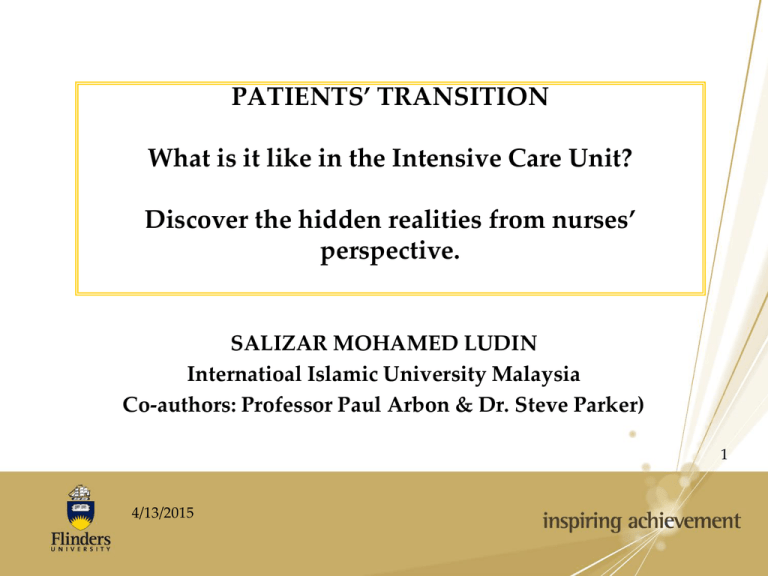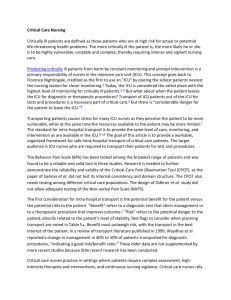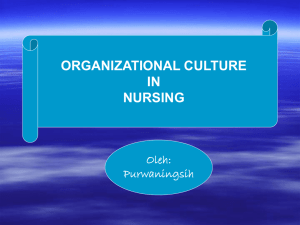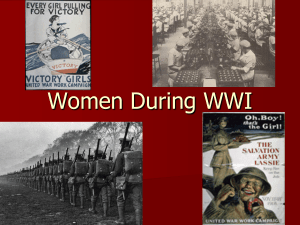Document
advertisement

PATIENTS’ TRANSITION What is it like in the Intensive Care Unit? Discover the hidden realities from nurses’ perspective. SALIZAR MOHAMED LUDIN Internatioal Islamic University Malaysia Co-authors: Professor Paul Arbon & Dr. Steve Parker) 1 4/13/2015 OVERVIEW • Conceptualisation of transition • Problem statement, Research aims and questions • Methodology • Research setting, design & methods • Ethical consideration • Data analysis • Rigor and trustworthiness • Findings • Interpretation & discussion • Recommendation • Summary 4/13/2015 2 Conceptualization of transition • The term ‘transition’ is derived from the Latin verb ‘transire’, meaning to go across (Chick & Meleis 1986). • The ‘Macquarie Concise Dictionary (2006, p. 1303) defines the noun transition as ‘passage from one state, stage, subject, or a change place to another or a movement, development, or evolution from one form, stage, or style to another’. 3 Conceptualization of transition Common definition of transition in nursing • Transition occur if an event or non-event results in a change in about oneself and the world, thus requires a corresponding change in one’s behaviour and relationship (Schlossberg 1981) 4 4/13/2015 The individual in Transition Theory (Schlossberg 1984) 5 Helping adults in transition: A content process model (Schlossberg, Lynch & Chickering 1989) 6 • A passage from life phase, condition, or status to another…refers to both process and outcome of complex personenvironment interaction (Chick & Meleis 1986). 7 • A process that involves three phases: ending, neutral, and a new beginning (Bridges 2003) 8 Characteristics of transition • • • • • • Critical events Awareness Disconnectedness Time span Engagement Change and difference 9 Types of transition • • • • Health –illness Developmental Situational Organizational 10 Transition and Nursing • The concept of transition is central to the nursing discipline because it focuses on the individual and their coping with the experience of clinical care (Meleis et al. 2000; Meleis & Trangenstein 1994). 11 Nurse-client encounters that often occur during transitional periods and the period of instability which may produce profound alterations in the lives of individuals and their significant others, have important implications for well-being and health (Schumacher & Meleis 1994). 12 • Consequently, a transition theory framework can facilitate an understanding of individuals in transition and their access to the help they need to cope with the ordinary and extraordinary process of living. • Such a framework may also be helpful in planning and providing more appropriate nursing interventions for patients experiencing transition. 13 Critically ill patients context • Careful conceptualisation of transition and its consequences in all the bio-psychosocial-cultural variations will assist nurses in providing therapeutic nursing to critically ill patients. 14 • Critically ill patients recovering from critical illness often suffer lasting physical and psychological effects and generally require a ‘package of care’ to support their complex needs when getting back to good health or a near normal condition (Foust 2007). • Adequate preparation of the critically ill patients and families is an important element of the recovering process. 15 Transition and critical care nurses • Transitions fall into nursing domain when it pertains to healthillness behaviours or when responses to the transition are manifested in health-illness behaviours (Chick and Meleis 1986, pg. 238). • Nurses’ contribution in patients’ cont’ care during patients’ transition is important as the critically ill patients in the ICU experience multiple transition as they moves across different level of care Chaboyer (2005). • Being transferred to a ‘general’ ward after severe critical illness or with consequential problems can be distressing and 16 challenging. • This study naturally focus on discharge and change of the patients’ situation during critical illness, however it has been recognised that there is increased importance in awareness of critically ill patients and families transition experiences including the journey while in C/ICU and following discharge from the unit. • As the critical and intensive care nurses are the primary caregivers in critical care contexts, their understanding of the critically ill patients’ transition is important to facilitate better nursing care and prepare the patients and families. 17 Critical care context Critical illness Health & illness transition experiences/journey Multifaceted treatment/ care 18 Problem statement • Transition of life after health & illness- chronic illness • Transition (movement) to other care setting- C/ICU patients • Discharge and discharge planning in C/ICU • Patients’ transition experience & nurses engagement in care 19 • 4/13/2015 Research aim Understanding the critically ill patients and their families’ transition experience. This is a vital aspect and it is argued that nurses should know how to assist patients and families during the transitions associated with hospitalisation and recovery from critical illness. 20 4/13/2015 Salizar M Ludin Research question What is the awareness of the critically ill patients’ transitional experience among the Malaysian C/ICU nurses? 21 Methodology Interpretive Description approach Is a qualitative research approach that requires an integrity of purpose deriving from actual practice goal and an understanding of what we know and don’t know from all available sources (Thorne 2007, p. 35) 22 4/13/2015 The framework - needs within nursing science and focuses on developing knowledge that will inform clinical practice (Hunt 2009) -experiential questions that are relevant to nursing in clinical area Goes beyond description - in-depth conceptual description stays closer to the data obtained (SullivanBolyai, Bova & Harper 2005). The analytic procedures - synthesizing, theorizing and re-contextualizing rather than just simply sorting and coding (Thorne, Kirkham & O'Flynn-Magee 2004). 23 SETTING Klang Valley (Selangor & K. Lumpur) HSEL UMMC Four (4) public tertiary Hospitals in Malaysia HTAR HKL DESIGN & METHODS 25 4/13/2015 SAMPLING & TOOLS Interview Focus group and in-depth-individual • Sampling-Purposive (5 FG and 10 individual interviews) • Interview schedule – Semi-structured questions 26 4/13/2015 ETHICAL CONSIDERATION • Flinders University Research Ethic Committee • Economic planning unit, Prime Minister Dept. Malaysia • National Medical Research Ethic Committee of Malaysia (government hosp) • Hospital directors(teaching hosp) 4/13/2015 27 DATA ANALYSIS Analysis underpinned by the idea of Grounded theory technique (Strauss & Corbin 1998) Interview (Group and individual) – Analysis tool- Nvivo8 software – Analysis method-GT method of analysis 28 4/13/2015 RIGOR AND TRUSTWORTHINESS • Use of framework in data collection and analysis • Participants’ confirmation of transcript • Expert opinion-questionnaires • Reliability test-questionnaire • Pilot-testing-questionnaire & question guide • Comparative analysis -GT analysis-back and forward analysis 4/13/2015 29 FINDINGS Coping Hope, faith and hopefulness Complex need Knowledge needs Altered physiological & psychological function Movement of location 4/13/2015 Comparison to previous model of transition Theory of transition (Schlossberg 1981) - Experiencing transition (middle range theory)(Meleis et al 2000) Continuous transition process Patients / families experience Nurses response 31 INTERPRETATION & DISCUSSION Hope and faith change Coping change Location change Skills and care change Knowledge change Patient’ transition HealthIllness change 32 Conceptual model: Patients’ transition - What is it like in ICU from nurses perspectives ADMISSION Transition experience C/ICU PATIENT S PRE-ADMISSION Therapeutic use of self Knowledge Continuous Transition Process Education Skills & care Hope & faith Coping FAMILY Location change Family centred care TRANSFER/ DISCHARGE NURSE Health-illness RECOMMENDATION Nursing education • Broader definition of transition Clinical practice • Broader definition of transition • Develop clear policies • Practical knowledge Future research • Detail exploration of the concept • Observe the patients’ transition experience • Test the conceptual model 34 4/13/2015 Salizar M Ludin CONCLUSION Patients’ transition is about continuous experiences through out their illness 4/13/2015 Co-authors Professor Paul Arbon Dean- School of Nursing and Midwifery Faculty of Health Sciences Flinders University, South Australia • Email: paul.arbon@flinders.edu.au President -World Association for Disaster and Emergency Medicine (WADEM) Director- Torrens Resilience Institute Dr Steve Parker Associate Dean (Teaching & Learning)- School of Nursing and Midwifery Faculty of Health Sciences Flinders University, South Australia • Email: steve.parker@flinders.edu.au 36 REFERENCE • Chaboyer, W, James, H & Kendall, M 2005, 'Transitional care after the intensive care unit', Critical care Nurse, vol. 25, no. 3 June, pp. 16-28. • Boutilier, S 2007, 'Leaving critical care. Facilitating a smooth transition.', Dimention of Critical Care Nursing, vol. 26, no. 4 JulyAugust. • Foust, JB 2007, 'Discharge planning as part of daily nursing practice', Applied Nursing Research, vol. 20, no. 2, pp. 72-7. • Meleis, AI, Sawyer, L, Im, E-O, Hilfinger, M, DeAnne, K & Schumacher, K 2000, 'Experiencing transitions: An emerging MiddleRange Theory', Journal of Advanced Nursing, vol. 23, no. 1, pp. 12-28 • Schlossberg, NK 1981, 'A model for analysing human adaptation to transition', The Counseling Psychologist, vol. 9, no. 2. 37 • • • • • Bridges, W 2003, Managing transitions: Making the most of changes, Nicholas Brealey Publishing, London. Kralik, D, Visentin, K & van Loon, A 2006, 'Transition: A literature review.', Intergrative Literature Reviews and Meta Analyses. Hunt, MR 2009, 'Strenght and challenges in the use of Interpretive Description: Reflection arising from a study of the moral experience of health professionals in humanitatrian work.', Qualitative Health Research, vol. 19, p. 1284. Thorne, S, Kirkham, SR & MacDonald-Emes, J 1997, 'Focus on Qualitative Methods. Interpretive description: A Noncategorical qualitative alternative for developing nursing knowledge.', Research in Nursing and Health, vol. 20, pp. 169- 77. Thorne,S, 2007, Interpretive description. Walnut Creek, Carlifornia, Leftt Coast Press, Inc. 38 39









